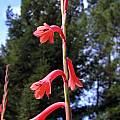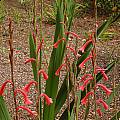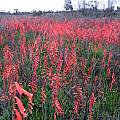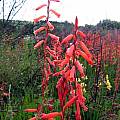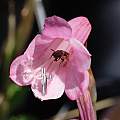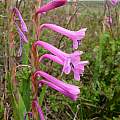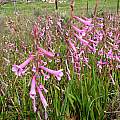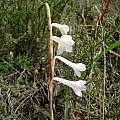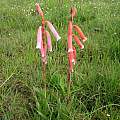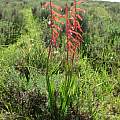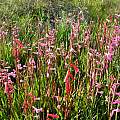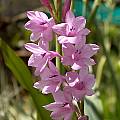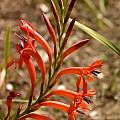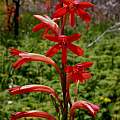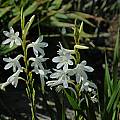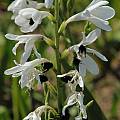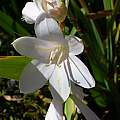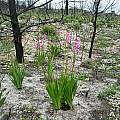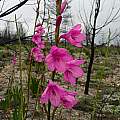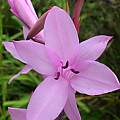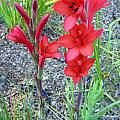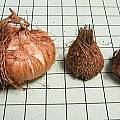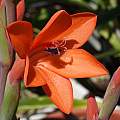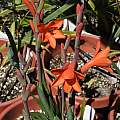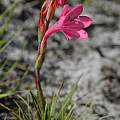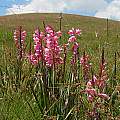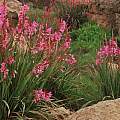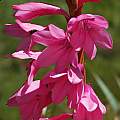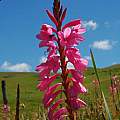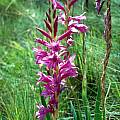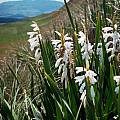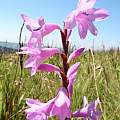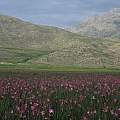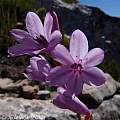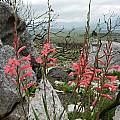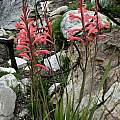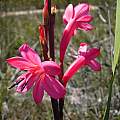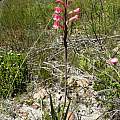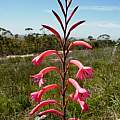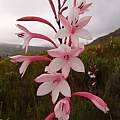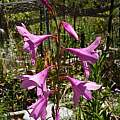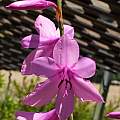Watsonia is a genus in the Iridaceae family of over 50 species in southern Africa where it is distributed from the mountains and coastal belt of the Western Cape to the Drakensberg escarpment of Swaziland and the eastern Transvaal. It therefore grows in both the winter and summer rainfall areas. Growing from a corm, species are both evergreen and perennial. Many are quite tall with fans of sword-shaped leaves and spikes of showy (often many) flowers that are usually pink, bright red or orange. Watsonia species a-f are found on this page.
Watsonia species g-m - Watsonia species n-z - Watsonia index
Watsonia aletroides (Burman fil.) Ker Gawler is a Cape species found on clay slopes in renosterveld and flowering in spring. It grows to 50 cm high with sword-shaped leaves and red, occasionally pink or mauve (rarely white) nodding tubular flowers in an unbranched spike. It flowers in spring and abundantly after fires. The first two photos are by Mary Sue Ittner of garden plants in Northern California where they are planted in the ground in the second picture next to Watsonia marginata leaves. The third and fourth pictures are by Rogan Roth of plants flowering abundantly in a seasonally wet and burnt area near the town of Swellendam, Western Cape. The fifth picture is of a very small pink form (under two feet / 0.7 m) grown in California by Michael Mace. There is a small bee hiding in the flower. This form blooms in late spring (mid-May) in California.
The photos below from Cameron McMaster show different color forms.
Watsonia amatolae Goldblatt occurs in the Eastern Cape in the Amatola Mountains. The purple pink flowers appear in summer. Height range: 0.4-0.6 m. Photos by Cameron McMaster.
Watsonia angusta Ker Gawler is evergreen, growing to 1.2 m and is found in montane marshes and streambanks in fynbos in many areas in the Cape Province to southern KwaZulu-Natal. It has scarlet flowers in a usually branched spike and multiplies rapidly. It flowers in summer and is suitable for a wet part of a garden. The first photo was taken by Cameron McMaster. The second photo is from the book Plants of the Klein Karoo courtesy of Jan and Anne Lise Schutte-Vlok.
Watsonia borbonica (Pourret) Goldblatt is a species from the Northwest and Southwest Cape where it is found on rocky sandstone slopes, on granite and clay at various elevations and blooming at different times from spring to summer. It grows from 50 to 200 cm and blooms best in the wild after a fire. It has large sword-shaped leaves and mostly purple-pink, occasionally white flowers. Detailed information about this species can be found on the South African National Biodiversity Institute's website. The first photo was taken in Alan Horstmann's yard in 2006. Photos two and three were taken at Lion's Head in the Table Mountain National Park showing flowers being pollinated by beetles. Those three photos were taken by Mary Sue Ittner. The last photo was taken at Drayton by Cameron McMaster.
Watsonia borbonica subsp. ardernei (Sander) Goldblatt has stamens that are bent downwards and anthers that lie flat but rise towards the tip. Height range: up to 2 m. The first photo was taken by Alan Horstmann. The next two photos were taken in the Overberg by Cameron McMaster after a fire. There is a tall form in cultivation that has white flowers known as 'Ardern's White' that has been growing in Southern California gardens for over 50 years.
Watsonia borbonica subsp. borbonica has stamens that are bow-shaped to horizontal and horizontal anthers. Photo by Alan Horstmann.
Watsonia coccinea (Herbert. ex Baker) Baker is found on sandstone flats and plateaus in the Southwest Cape and Agulhas Plain. In spite of the name, flowers can be scarlet, purple, or pink. It is a short species (under two feet; 2/3 of a meter) and a very pretty one, and is easier to grow in pots than most Watsonias. I haven't found it to be a reliable bloomer in that it skips some years. Unlike some it does not appear to increase very much either. First two photos by Mary Sue Ittner of flowers and of corms on a grid of 1 cm squares. Third and fourth photos are by Michael Mace of a form received as seed from Kirstenbosch Garden, back in the happy days when it still sent seed to foreign members. The last photo is from Rachel Saunders.
Watsonia confusa Goldblatt grows in damp sites or grassland along the coast and inland in the Eastern Cape Province to KwaZulu-Natal. It is large, up to 1.5 meters, and has more or less 30 pink to purple flowers on an unbranched stem. The first photo was taken by Cameron McMaster January 2008 at Elands Heights, Maclear. The second photo was taken by Rod Saunders. The last three were taken January 2010 at Maclear by Mary Sue Ittner.
Watsonia densiflora Baker is a common summer-growing species found in the midlands and uplands of KwaZulu-Natal. Two color forms of this species are illustrated here. Height: to about 1 m. Photos 1 to 2 by Rogan Roth. The last photo was taken by Rod Saunders.
Watsonia distans L.Bolus is a rare plant found in only one remaining site in the Southwestern Cape where it grows in mountain marshes, flowering in late summer (November to December). Growing from 15 to 35 cm or taller, it has sword-shaped leaves and deep pink short-tubed flowers. Photo from Rod Saunders.
Watsonia emiliae L.Bolus is found on rocky outcrops in fynbos in the Langeberg and Swartberg Mountains. It grows to 60 cm, has narrow leaves and short tubed pink flowers, and flowers in summer. The photo below is from the book Plants of the Klein Karoo courtesy of Jan and Anne Lise Schutte-Vlok.
Watsonia fourcadei J.W.Mathews & L.Bolus grows on rocky sandstone slopes from the Western Cape to the Eastern Cape to Swaziland. It flowers November to January. This species grows to 2 meters and has sword-shaped broad blue grey leaves and mostly orange to red, rarely pink or purple, large flowers in elongate spikes. The first four photos by Cameron McMaster were taken at Caledon and Napier Mountain in the Overberg. The last photo is from the book Plants of the Klein Karoo courtesy of Jan and Anne Lise Schutte-Vlok.
The photos below show the pink form, grown in California by Michael Mace from seeds supplied by Kirstenbosch. In California it blooms in early June.
Watsonia species g-m - Watsonia species n-z - Watsonia index
